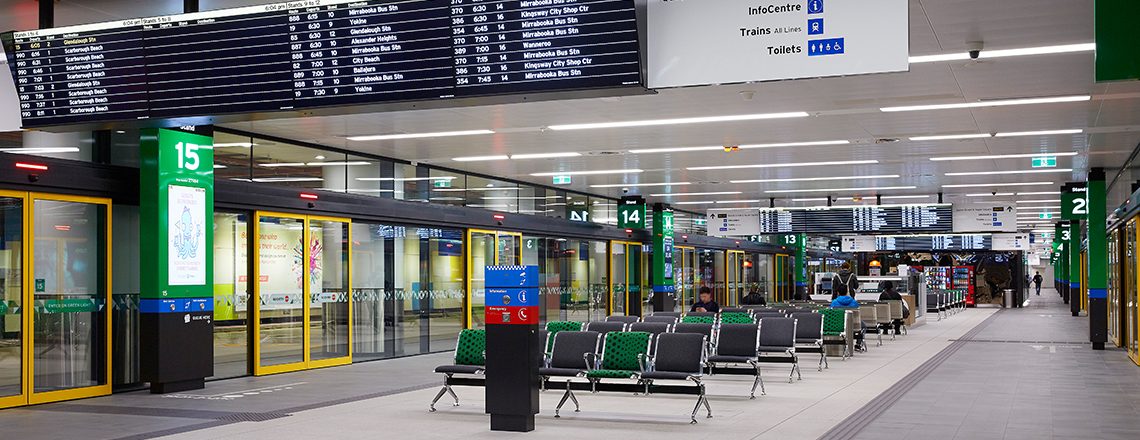
WGE proudly helped deliver the innovative new Perth Busport which is set to handle 28,000 passenger movements each day.
Opening to Perth commuters on 17 July, the Perth Busport represents a key piece of the transportation strategy for Perth and is critical to the finalisation of Perth City Link, connecting the CBD with Northbridge for the first time in more than 100 years.
WGE have provided acoustics, electrical and communications, fire engineering, fire protection, hydraulics, sustainability and vertical transportation services in the design and construction phases of the project.
Project details:
- It was designed with passenger comfort and safety in mind, offering accurate destination information, reduced wait times and a welcoming, easy to navigate passenger lounge.
- A number of bespoke systems were designed and engineered by the WGE team to meet the unique and complex requirements of the Public Transport Authority.
- The intelligent transport systems adopted by the Public Transport Authority (PTA) include dynamic allocation of bus stands within the busport, GPS tracking of all Transperth buses to enable new smartphone applications, traffic signal prioritisation and new wayfinding and audio visual systems to assist passengers to quickly find their bus.
- WGE have integrated these technologies onto the PTA’s existing state-wide Supervisory Control and Data Acquisition (SCADA) network which remotely operates all rail stations and rail tunnels within the Perth metropolitan area.
Why a multidiscipline approach was beneficial
The project required a high level of multi-discipline services integration which resulted in a number of cost and efficiency benefits for the client.
At the start of the project, a team of specialists were selected from WGE based on experience and track-record for delivery of complex projects. A dedicated services coordinator was appointed to provide a single point of contact for the Client to address key issues and formal communication.
The WGE team worked together to brainstorm and problem solve the interaction between individual building systems to achieve a cohesive, streamlined and manageable system for the PTA. As a result, complex systems within the busport communicate together to provide a unified response to system operation, critical incidents and emergencies.
Inter-discipline communication resolved key interfaces and any incidental and unforeseen services clashes, avoiding unnecessary project delays. The team’s proactive and collaborative approach to negotiating services interfaces meant that systems were designed right the first time, avoiding multiple revisions.
Given the highly complex nature of the Perth Busport, services integration was defined as a separate discipline to engineer the interfaces between specialist engineering services. This resulted in reduced capital costs through the ‘sharing’ of infrastructure across the project. For example, a single converged IT network provides all connectivity for building systems from CCTV to SmartRider ticketing.
Perth Busport fast facts
- Designed to be integrated into the future buildings that will rise above the three entry halls at ground level – underground structure is designed to bear the load of future high-rise developments with the Kings Square precinct
- Dynamic stand system works more like an airport to increase the number of buses per hour and maximise efficiency
- A Wi-Fi network tracks each bus within 1km and sends instructions to drivers
- Special Radio Frequency Identification (RFID) units mounted on top of all buses to track each bus to +/- 10 metres within the Busport
- A network of fibre optic heat sensors monitors the entire underground area and can detect a bus that is running hot or beginning to combust
- There are over 130 CCTV cameras throughout the site
- A facility control officer monitors all essential systems: gas, smoke, fire and heat detection, ventilation, CCTV, communications and security
- The main tunnel into the Busport is galvanically isolated from the rest of the facility to prevent faults on the train network interrupting Busport operations
- Safety is maximised as autodoors in the passenger lounge will only open for passengers to board when a laser system registers that the bus doors are open. This also:
- Protects the lounge from fumes and odours
- Ensures air conditioning efficiency within the passenger lounge on hot and cold days
- The Busport has a deluge-type fire suppression system that releases almost 10,000L of water per minute
- A mobile incident response briefcase provides critical real-time data using touch-screen technology for fire and emergency response teams
- Many aspects of the design meet international standards, as the complexities of the project go beyond the applications of Australian Standards
